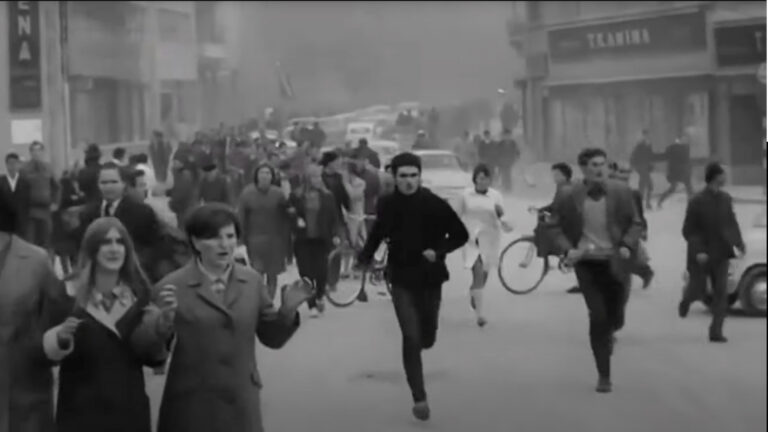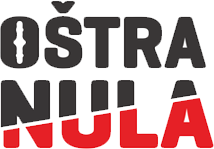This earthquake left a deep mark on the collective memory of the citizens and the development of infrastructure in Banja Luka, as well as on the way the community organized to deal with the consequences of natural disasters.
In Banja Luka’s Krajina Square, there is a clock whose hands are forever stopped at 09:11. Some started calling it the “crooked clock” because it is mounted on a metal pole shaped like a sine wave.
However, this is not just any “crooked clock” – it is the very same clock that stood there on October 27, 1969, when Banja Luka was hit by the strongest earthquake in its history.
When the ground began to shake on October 27 at 9:11 AM, the clock in the square stopped working due to a power outage. Later, it was placed on a new pole, which could symbolize either the rupture that occurred in the city or a graph representing the earthquake.
The earthquake was preceded by one that occurred on October 26 at 4:36 PM, which was recorded by other seismological stations around the world. The strength of the earthquake is evident from the estimate that it caused $50 million in damage.
Today, the “frozen-in-time” clock reminds the people of Banja Luka of the strongest earthquake in the city’s history, which claimed 15 lives and left 1,117 people injured, both seriously and lightly. The destruction in the city was extensive – around 20,000 buildings were damaged, and more than 200 structures were completely destroyed. Additionally, many buildings had to be demolished later due to severe damage or structural issues.
The low number of casualties was attributed to the wise decisions made by the leadership of the Banja Luka Municipal Assembly (SO). After the smaller earthquake on October 26, they decided that children would not go to school and workers would not go to their jobs. This decision undoubtedly saved many lives.
The strongest earthquake that hit Banja Luka on October 27 at 9:11 AM had a magnitude of 6.4 on the Richter scale, which measures the seismic energy released by the quake. The hypocenter, or the focus of the earthquake, was located 20 kilometers beneath the city. On the Mercalli scale, the earthquake had an intensity of 8 degrees in the epicentral area. The Mercalli scale describes the effects and changes caused by earthquakes on people and animals, assesses the extent of damage to structures, and evaluates the environmental changes resulting from the quake.
According to the scale defined in 1935 by American seismologist Charles F. Richter, the Banja Luka earthquake falls into the category of strong earthquakes, capable of causing damage in populated areas up to 160 km from the epicenter. Earthquakes of this magnitude typically occur once every 120 years.
For many citizens of Banja Luka, the earthquake was a shock, as it came at a time when large earthquakes in the area were considered rare. According to some data, the first notable earthquake in Banja Luka occurred in 1888. The one that hit in 1935 had a magnitude of 5.5 on the Richter scale, followed by the powerful earthquake in 1969. Another earthquake with a magnitude of 5.4 hit Banja Luka in 1981.
Those who experienced the 1969 earthquake surely remember the deep rumble coming from the ground and the flocks of birds that, disturbed, flew out of their nests. Then chimneys began to fall, parts of buildings or entire structures collapsed, and a large cloud of dust rose above the city.
This is how the BBC reported on the 1969 earthquake.
Most children welcomed the earthquake because it meant no school and the freedom to play in the streets as much as they wanted. Staying inside houses and apartments was not advised until commissions assessed their structural integrity. Only the bravest slept in their homes, while most residents of Banja Luka spent their nights in tents or garages.
The municipal authorities responded swiftly after the earthquake. On the first day, the biggest challenge was the hospitals and how to provide care for the injured. A particular issue arose because the General Hospital in Banja Luka became practically unusable due to the quake, prompting the organization of an improvised hospital. The 15 most severely injured individuals were airlifted by helicopters, while 50 others were transported by bus to Zagreb and other medical centers. Three people later died from the effects of the earthquake, and two are counted as victims even though they died in a traffic accident.
The Yugoslav People’s Army (JNA) soldiers provided significant assistance, immediately taking to the streets of Banja Luka to clear the rubble. Additionally, they secured buildings, as there was concern about potential looting in abandoned homes and apartments.
By October 30, the municipal bulletin began to be published, providing residents with information about the situation in the city. From the first issue, citizens learned that just two days after the earthquake, Banja Luka’s radio station and the newspaper “Glas” were restored and operational.
Aid began arriving in Banja Luka not only from across Yugoslavia but from all over the world. During and after the earthquake, solidarity among the citizens of the former SFRY was remarkable. Many mobilized to provide assistance, donations, and shelter for those who had lost their homes.
Various organizations, including the Red Cross, organized aid collection campaigns. People from other cities came to help with the reconstruction and offer support to those affected.
One interesting fact is that after the earthquake, the people of Banja Luka were allowed to purchase technical goods in Italy without paying customs duties.
Delegations from all over Yugoslavia – including Belgrade, Sarajevo, Leskovac, Kranj, Pirot, and others – arrived in Banja Luka, offering concrete assistance. Prominent political figures from across SFR Yugoslavia also visited the city.
Two days after the earthquake, Josip Broz Tito arrived in Banja Luka by helicopter. Without the usual security procedures in place, he walked through the city, greeting the people of Banja Luka, especially the children. This lack of security caused issues for his security services afterward, and it is assumed that Tito’s visit was unannounced. Later, everyone who had interacted with Tito was questioned – “What did you talk about? What did he say to you?”
Three days after the earthquake, the first session of the Banja Luka Municipal Assembly was held, during which the then-president of the assembly, Živko Babić, presented a report.
The housing stock suffered severe damage. The Housing Commission, which began its work immediately after the initial earthquake on October 26, was joined by experts from Skopje. Within the first three days, they inspected the majority of buildings, as reflected in the report.
Today, this seems incredible when compared to the actions of current authorities in Bosnia and Herzegovina following the catastrophic flood and landslide in Jablanica on October 4, 2024, and their response in the first three days.
Most educational and cultural buildings were so damaged that further use was impossible. As a result, many students had to be sent to other cities in Yugoslavia for schooling. Banja Luka’s high school students, for example, were sent to Crikvenica.
The same situation applied to industrial facilities, but their reconstruction began immediately.
Banja Luka suffered significant infrastructure losses, and the rebuilding process lasted for years. The city lost a substantial part of its economic activity, which affected the citizens’ standard of living. The social structure also faced challenges due to displacement and the loss of households. After the earthquake, there was a surge in migration to Banja Luka as the city turned into a large construction site.
The earthquake also led to changes in construction norms and regulations, resulting in stronger construction standards in the region. As a result, the relatively strong earthquake that hit Banja Luka in 1981 caused no significant damage.
This earthquake left a deep mark on the collective memory of the citizens and the development of Banja Luka’s infrastructure, as well as on the way the community organized to confront the consequences of natural disasters.
Gordana Katana



